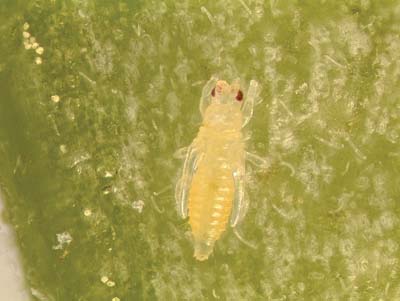Florida Flower Thrips, Frankliniella bispinosa
(Thysanoptera: Thripidae)
The Florida flower thrips is a common species throughout southern Florida and is increasingly common in northern Florida and southern Georgia. The egg is round and kidney-shaped with a pale or yellow surface. The larva is lemon yellow and resembles the adult except for its lack of wings. The two larval instars are followed by two non-feeding stages, a prepupa and a pupa.
Vegetable crops that are commonly infested include tomato, pepper, eggplant, cucumber, potato, watermelon, tomatillo, beans, strawberry, squash, and sweet corn. The Florida flower thrips feeds primarily on blossoms. Tissue infested by thrips may have a shrunken appearance and infested blossoms may turn brown and buds may open only partially. Insecticides are not commonly used to control Florida flower thrips. Because their damage is usually tolerable, they compete very well with more serious pests for resources in the blooms of sensitive crops, and they serve as a good food source for generalist predators that help to control other more damaging species of thrips. When insecticides are used, the lowest rates with short residual activity are usually sufficient to bring Florida flower thrips populations under control.
Images
To save the Web-optimized images shown below to your hard drive:
PC users: right click to "Save Picture (or Image) As..."
Mac users: click and drag to your desktop.
Copyright © 2005 University of Florida


